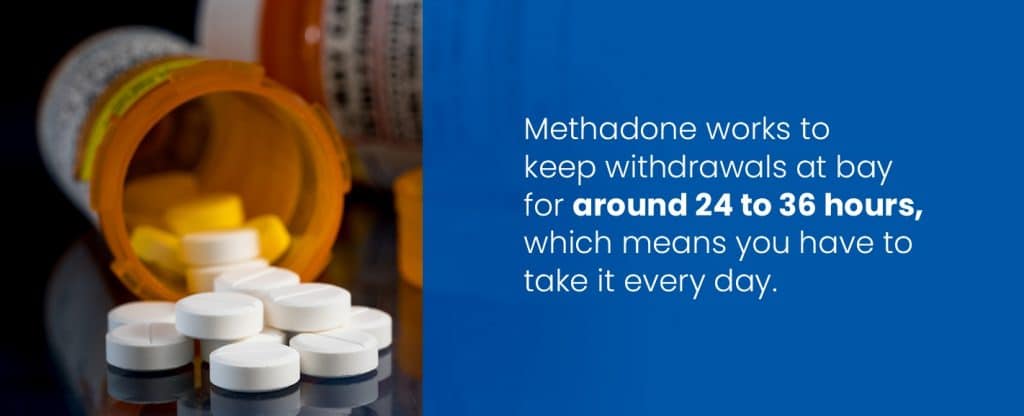Opioid addiction is a severe brain disease that requires treatment if the individual wants to live a life free of substance abuse. When choosing a form of addiction treatment for opioids, there are many options from which to select. Methadone maintenance treatment is a form of medication-assisted treatment (MAT) that is, in some cases, effective for people who wish to invest in changing their lives. Methadone may allow those with an opioid addiction to live relatively functional lives while receiving treatment for their addiction, but it isn’t for everyone and has severe drawbacks to consider.
What Is Methadone, and How Does It Work?
Methadone is a synthetic opioid agonist, meaning that it is a human-made medication that works on opioid receptors in the brain. Its’ effects are similar to other opioids like prescription painkillers, but they are less pronounced and last for a longer period.
Methadone fills opioid receptors, helping the brain maintain its chemical equilibrium and preventing people from experiencing the pain of withdrawals. It also helps reduce drug cravings. When taken as directed by someone who is already dependent on opioids, methadone does not result in a person getting high — it keeps them feeling healthy enough to live their lives without abusing opioids.
Only opioid treatment programs certified by the Substance Abuse and Mental Health Services Administration can dispense these medications. These programs must offer some form of counseling or therapy alongside the medication.
3 Reasons to Be Wary of Methadone Treatment
Methadone is the most commonly used medication in MAT. However, there are several reasons to choose other medications. Here are some reasons why methadone treatment may not be the best option for you:
1. Potential for Abuse and Overdose
Methadone is still an opioid, and it continues to increase in effectiveness the more a person takes. Therefore, if someone gets hold of enough methadone, they can take it all at once and get high. This potential for abuse is why methadone programs are under such strict regulations, and why people do not receive take-home doses until they have established themselves in the program.
The most recent study regarding methadone abuse and overdose was published in 2017 and reveals disturbing statistics about misuse of the drug. It found that, in 2014, methadone accounted for just 1% of all opioids prescribed for pain but was responsible for about 23% of all deaths related to prescription opioids.
One of the reasons behind the high overdose rate is the fact that methadone stays in the system after its pain relief and withdrawal-blocking effects are over. Although the person may not feel the effects of methadone anymore, it is still depressing their breathing and affecting their heart rate in unpredictable ways. If someone has chosen to abuse methadone to get the high, they are likely to take another dose before the respiratory and cardiac effects of the first dose have ended, compounding their breathing problems and greatly increasing their chances of a fatal overdose.

2. Lack of Flexibility
One of the most significant hurdles of overcoming addiction is developing personal accountability. Methadone treatment is a poor option for many people due to its highly structured nature. Methadone works to keep withdrawals at bay for around 24 to 36 hours, which means you have to take it every day. Due to the rigorous controls on the medication, it must come from a certified opioid treatment program under supervision during the early days of treatment, so those taking it must attend a clinic each day.
Initially, clients at a methadone program can only receive one “take-home” dose per week, for the day when the clinic is not open. Otherwise, daily attendance is mandatory, no matter the circumstances. After 180 days, participants can earn two take-home doses, and after 270 days, they can earn three take-home doses. The maximum take-home amount is a one-month supply, earned after two years of continuous treatment and meeting specific criteria.
3. A Diminished Sense of Normalcy
When people imagine addiction treatment, they typically think about residential programs that last about a month. These programs can be effective, but they require a tremendous upheaval in one’s personal life, as participants must put jobs, school and home responsibilities on hold to complete them.
Methadone maintenance allows patients to live at home, but is still quite difficult to fit around part-time work, school or child care, making it extremely challenging for participants to retain some sense of normalcy while receiving treatment. It is almost impossible to be discreet about participating in a methadone maintenance program. Methadone treatment still comes with an immense amount of stigma, which is often a factor in people choosing to abandon treatment. With buprenorphine, on the other hand, you get a prescription that you take to the pharmacy and have filled, just like any other medication. Once you are stable on buprenorphine, you may only need to visit your physician one time per week, and even less once you are in the maintenance phase.

Why Buprenorphine Is a Safer Option
Buprenorphine works similarly to methadone in that it prevents withdrawal and lessens drug cravings, but it has some notable advantages, like a lower potential for abuse. AppleGate provides office-based opioid treatment for the greatest convenience. You will still have regular appointments with a physician and attend counseling, building accountability and crucial coping skills for your continued recovery.
Another significant difference with buprenorphine is its ceiling effect. Whereas taking more methadone will result in increasingly strong effects, buprenorphine has a ceiling where after a specific dosage, the effects of the medication level off, even when a person takes more. That makes it much harder to abuse buprenorphine.
The buprenorphine compound Suboxone® takes things a step further with the inclusion of naloxone. Naloxone on its own is a way to quickly reverse opioid overdoses by taking over opioid receptors in the brain. When paired with Suboxone®, it serves as a deterrent. If someone tries to crush the medication for snorting or injection, it activates the naloxone and sends the person into immediate withdrawal. In combination with the ceiling effect, this feature makes Suboxone® incredibly difficult to abuse.
How AppleGate Recovery Can Help
No one sets out to become addicted to opioids, and people from all walks of life can find themselves struggling with substance abuse. Addiction only worsens over time, so seeking appropriate and effective treatment can save lives. AppleGate Recovery provides MAT using buprenorphine and its compounds.
If you’re ready to free yourself from opioid addiction, AppleGate recovery is here to help. Call us at 888-488-5337 or contact us online to learn more about your next steps to a drug-free life.

Contact AppleGate Recovery Today
If opioid addiction is impacting your life or the life of someone you care about, reach out to our treatment center. We are here to provide the support and care you need to take the first step toward recovery.
Call 888.488.5337
